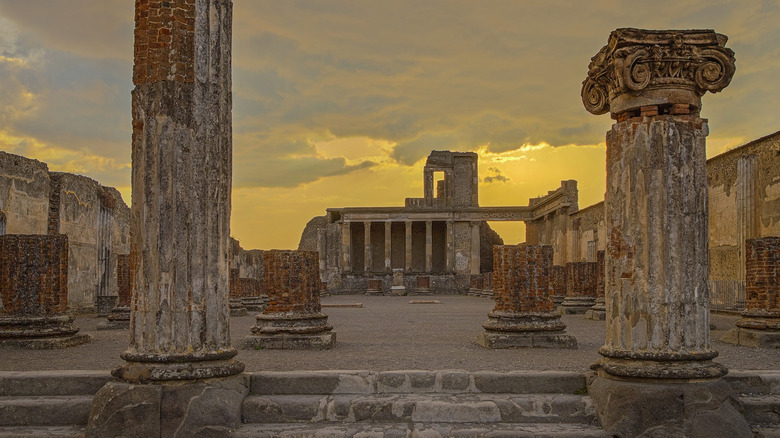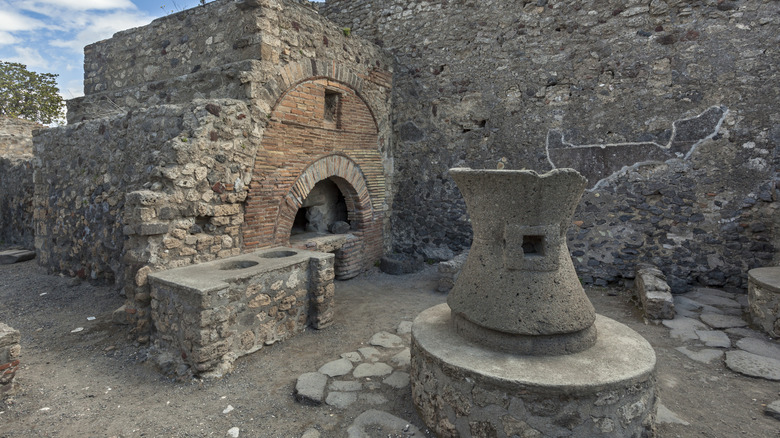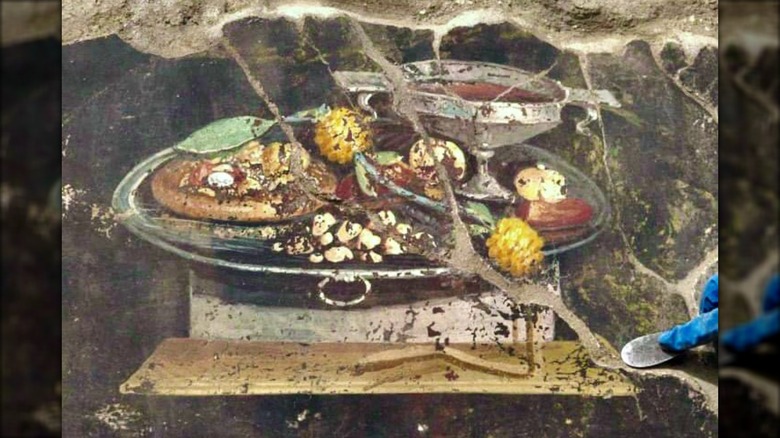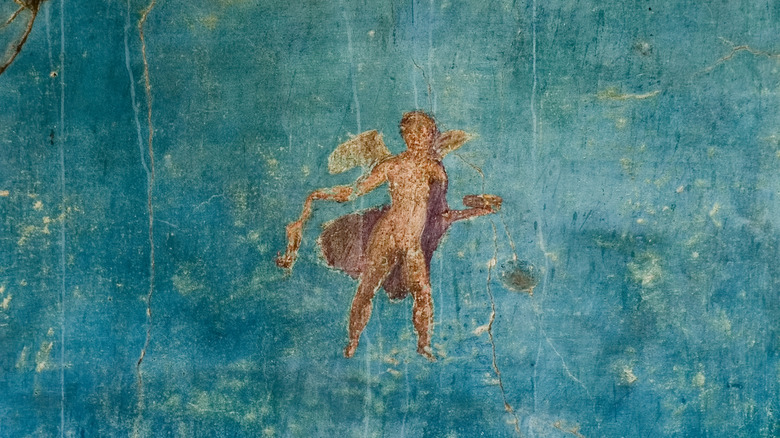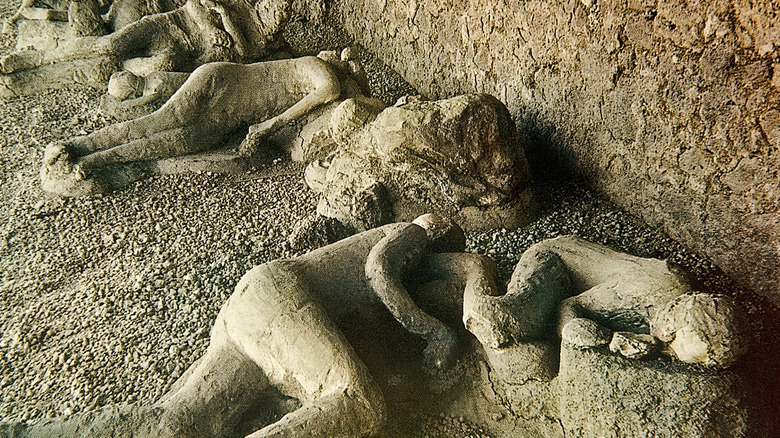5 Recent Pompeii Discoveries That Archeologists Didn't Expect
The ancient Roman city of Pompeii was wiped out by the violent eruption of Mount Vesuvius, the nearby volcano which in 79 A.D. exploded ash and pumice stones in a 10 mile wide cloud. The debris rained down on the city for 12 hours, forcing the majority of the 20,000 residents of the city to flee their homes.
Some, however, stayed behind, hoping to shelter from the destruction. And as archaeologists discovered when they first excavated the site in the 16th century, many of their bodies' remains, as well as their possessions, homes, and even their pets, had been immaculately preserved by the volcanic ash. Today, Pompeii is a major tourist attraction, as well as a site of continued archaeological interest, with groundbreaking discoveries being unearthed year after year which reflect the unexpected sophistication of daily life in a Roman city.
In January 2025, outlets reported one such impressive new find: a private spa complex, which had been uncovered on the grounds of a villa belonging to a wealthy Pompeii family. The spa features sumptuous baths, changing rooms, a "warm room" with hot air circulation, and a deep pool for cold dips, all decorated with incredible mosaics and frescoes of athletes. The discovery gave a fresh insight into the luxurious lives of the city's richest inhabitants — but it is not the only recent discovery to make headlines.
A Prison Bakery
In December 2023, a Pompeii Sites press release described how in an excavation plot named Region IX, Insula 10, where excavations had uncovered a house, and where work was being undertaken to secure the walls of the dig site, archaeologists had made a grim discovery. Excavators discovered a chamber containing three bodies in an ancient bakery. The space, which contains evidence of a millstone and marks denoting that it was operated by a donkey and an enslaved person, has no doors except a single exit leading into the atrium of the house. The high windows are barred.
Experts who have examined the findings have described it as a "prison bakery," commenting on the brutal work conditions that the enslaved donkey driver would have been expected to exist in. "It is, in other words, a space in which we have to imagine the presence of people of servile status whose freedom of movement the owner felt the need to restrict," writes Director Gabriel Zuchtriegel in an article for Pompeii Sites. Despite the ingenuity of the systems in place, the bakery's inhumanity is challenging for most modern people to accept. "It is the most shocking side of ancient slavery, the one devoid of both trusting relationships and promises of manumission, where we were reduced to brute violence, an impression that is entirely confirmed by the securing of the few windows with iron bars," Zuchtriegel writes. The discovery adds to a growing body of knowledge about Pompeiian dining culture, including the presence of a so-called fast food restaurant.
A 2,000-year-old pizza mural
Many of the sumptuous houses in Pompeii were so immaculately preserved by the ash — which submerged the city up to a height of 17 feet — that the artworks adorning the walls of the homes of wealthy look as vivid today as they did 2,000 years ago. Indeed, some recent discoveries have provided fresh evidence of the incredible artistic talent present in Pompeii at the time of the disaster, as well as insights into the citizens' everyday lives.
June 2023 saw the uncovering of a detailed still life painting of a plate containing contemporary food. Found in the atrium of the same house that housed the prison bakery, it is believed to have been a representation of food that would be offered to guests at the house. On the plate stands a vessel that appears to contain soup or wine, which is surrounded by a selection of vegetables. However, what has excited experts more is an object on the left, which appears to be a small doughy object with various toppings that uncannily resembles a modern pizza — albeit a miniature one. Could Italian cuisine really still closely resemble a Pomeiian dish from two millennia ago? The experts are open to the idea.
"It's impossible not to think of pizza, which began life as a poor man's dish in southern Italy, but has now conquered the world and is even served in Michelin-starred restaurants," Gabriel Zuchtriegel said in a statement (via en.vols.com).
Paintings of a lost city
Further exceptional works of Pompeiian art were reported to have been uncovered in April 2024, many of which reflected the cultural interests of citizens of the day. Described as some of the finest works of art ever discovered in Pompeii since it was first excavated in the 16th century, the frescoes were discovered in a room with an immaculate white mosaic floor with dark walls, which archaeologists are calling the "black room." It is believed that the room was for entertaining guests after sunset, with the black walls helping to hide soot from the oil lamps that would have been used to illuminate the room. The space is part of the same residence that contained the prison bakery and the "pizza" mural.
Among the artworks found in the black room are scenes featuring legendary scenes from the Trojan War, which took place 12 centuries before Pompeii was destroyed. One includes the famous meeting between Helen of Troy and Paris, the prince of the city, who eloped together and became the catalyst for the conflict, according to legend. Other scenes include mythological figures and Greek gods, such as Apollo and the prophet Cassandra, while a nearby staircase showed suggestive charcoal drawings of gladiators. The artworks are believed to have been created just a few decades before the city was destroyed. "Pompeii is truly a treasure chest that never ceases to surprise us and arouse amazement because, every time we dig, we find something beautiful and significant," Italian culture minister Gennaro Sangiuliano told The Guardian. The site has also been the place of discovery of simple children's sketches, showing hunters, gladiators, and animals.
The Blue Shrine
Another notable discovery took place two months later in June 2024, when archaeologists at the site uncovered what is now known as the "blue shrine." Technically referred to in Latin as a sacrarium, the chamber would have been used for rituals and blessings. The use of blue paint, which was very rare and difficult to obtain 2,000 years ago, suggests the high regard the citizens of Pompeii would have had for the room and the ceremonies that took place in it.
The walls are decorated with expertly drawn figures, mainly women, representing the four seasons and various farming methods, and what appear to be imitations of religious structures, along with several decorative patterns. The room would also have been used to store objects, and the initial excavation revealed the presence of 15 transport amphorae — large earthenware jugs — as well as bronze jugs and lamps.
Bejewelled skeletons
Along with the incredible architecture still standing on the site as if it had been built only yesterday, Pompeii is famous for the gruesome discovery of human remains that seem to have been frozen in time during the eruption of Mount Vesuvius, their bodies encased in ash. Over 1,000 bodies have been uncovered in Pompeii down the years, though the most famous human figures at the site are undoubtedly those set in casts by archaeologists — that's right, the exteriors aren't the original ash that covered the residents of Pompeii because the bodies decomposed under the ash, leaving only skeletons, so casts were made by pouring material into the shapes left in the hardened ash to reveal the last moments of the dead, which can be viewed by the public in the Garden of the Fugitives.
Those figures were first discovered in the early 1960s, but bodies continue to be uncovered and give a sense of the scale of devastation that struck Pompeii two millennia ago. As well as those discovered in the prison bakery, remains found in Pompeii in recent years include two skeletons, one male and one female, who in 2024 were discovered in what was believed to be a temporary bedroom in which they slept while their house — that which contained the Black Room, the Blue Shrine, and so on — was undergoing renovations. Reiterating the wealth and grandeur of some of the residents of Pompeii, the woman, who was on the bed, was found surrounded by precious artifacts, including jewelry such as gold and pearl earrings, and gold, silver, and bronze coins.
